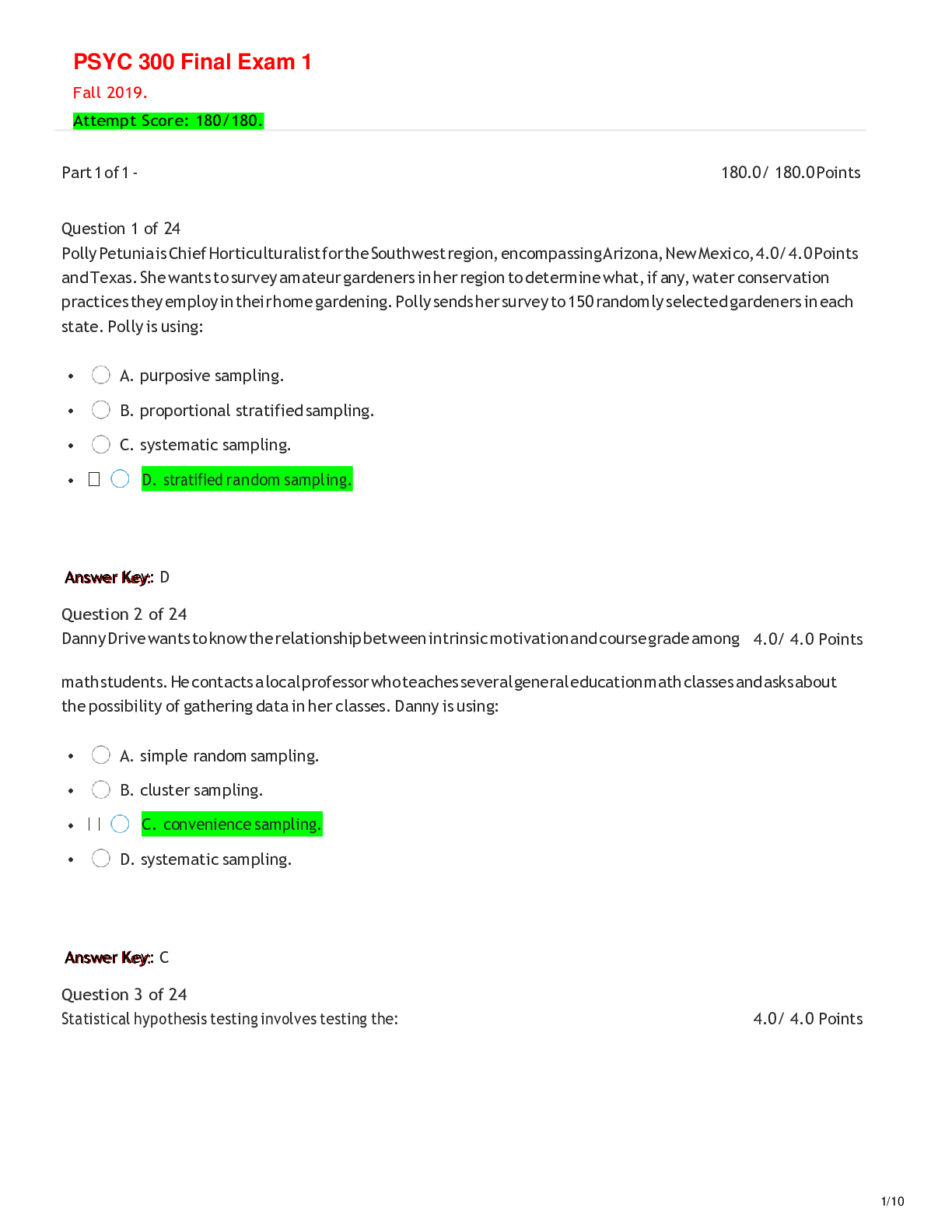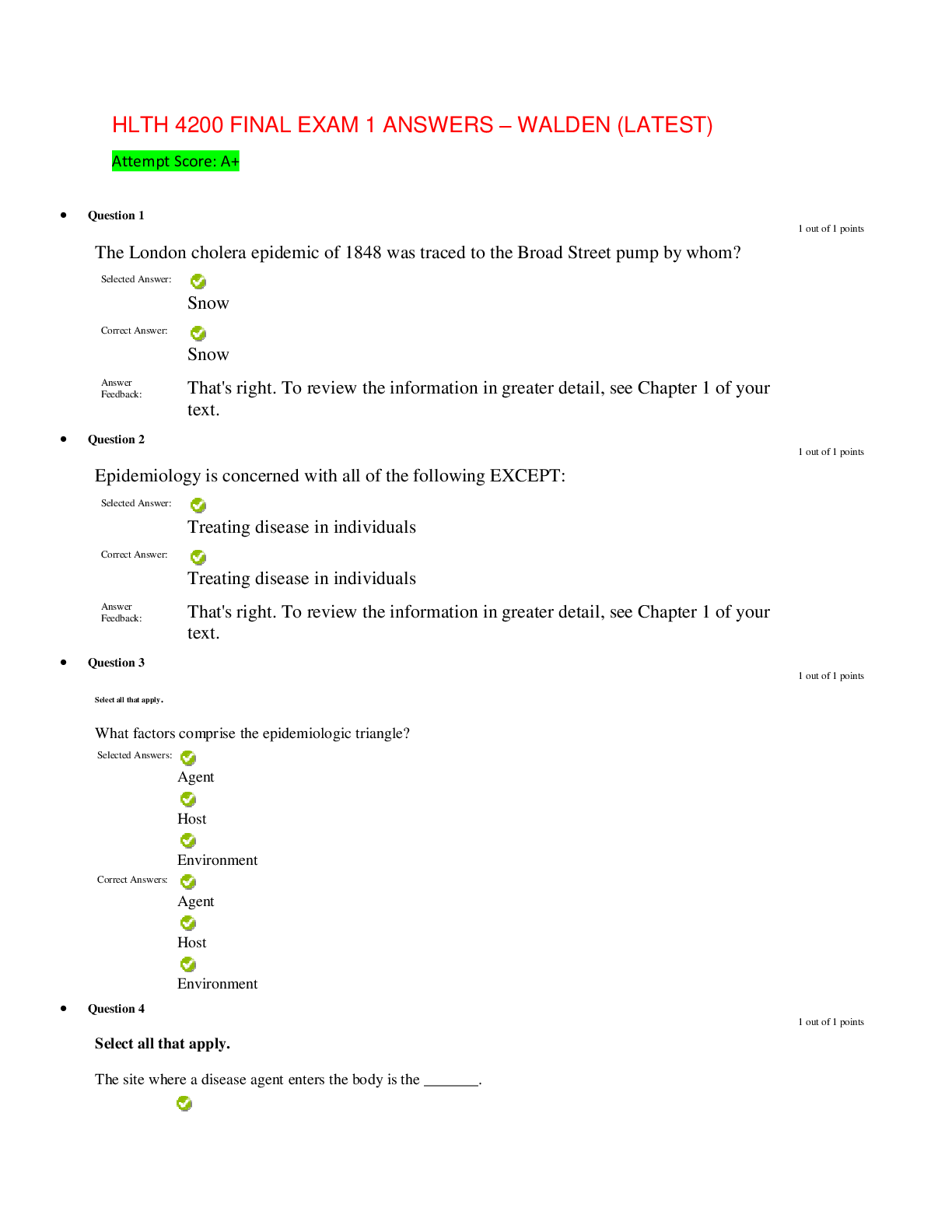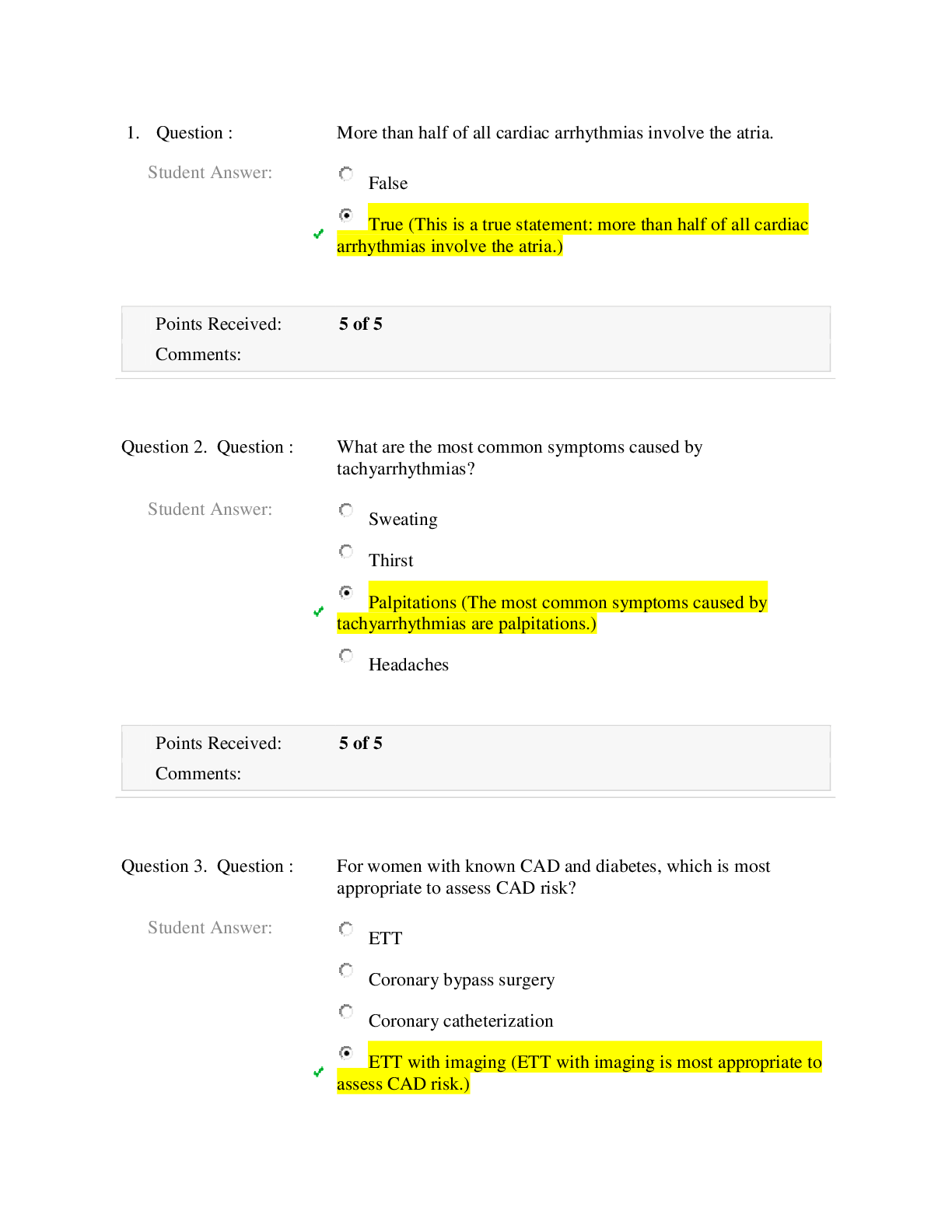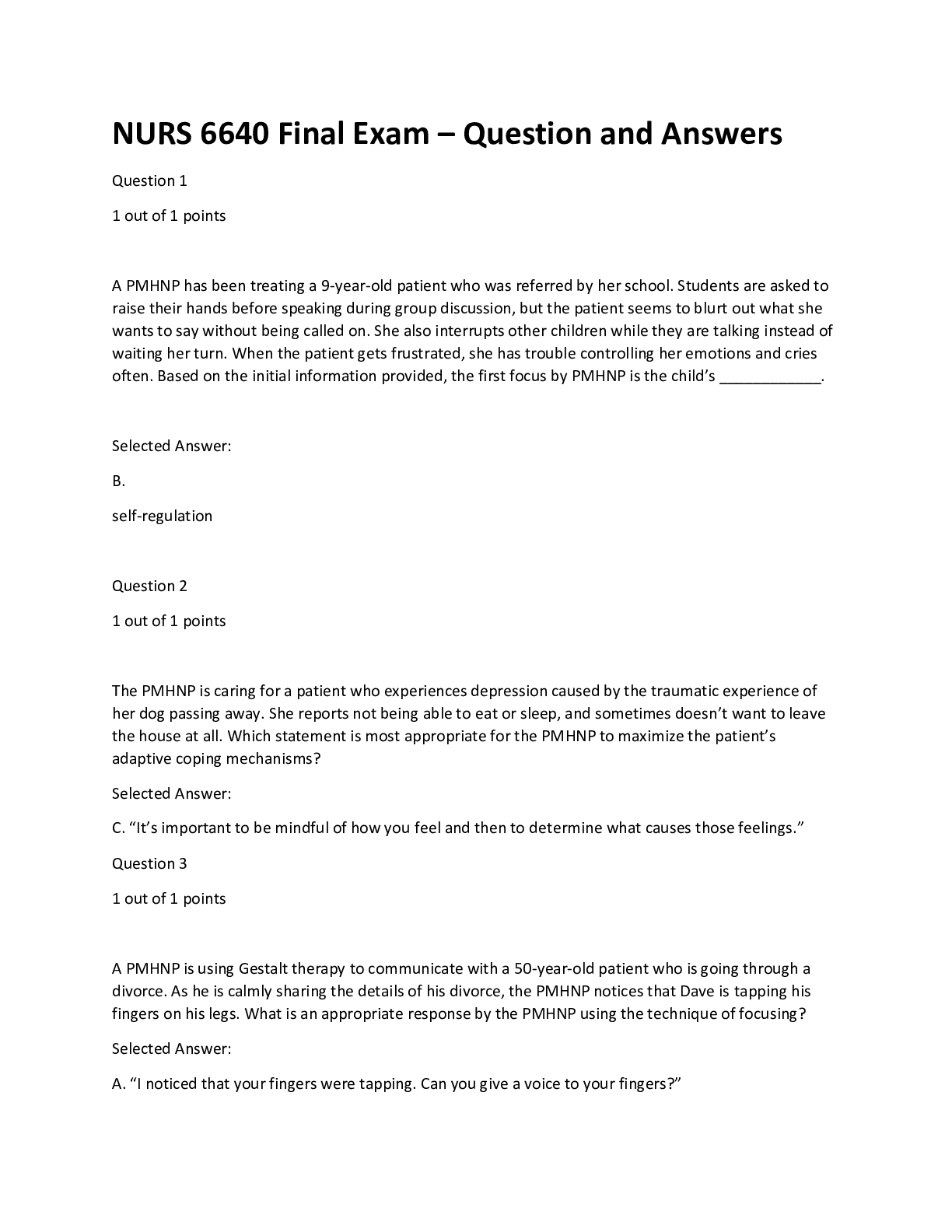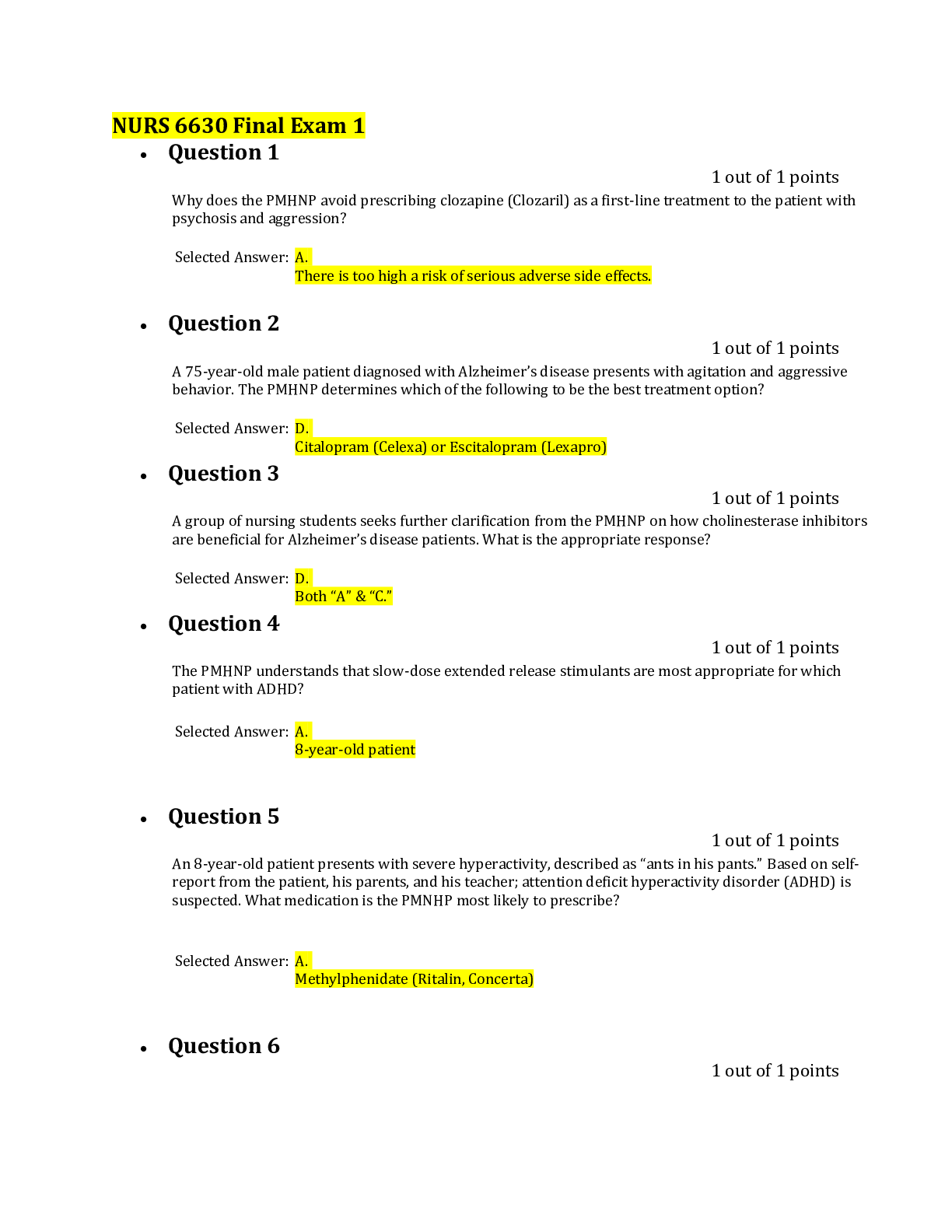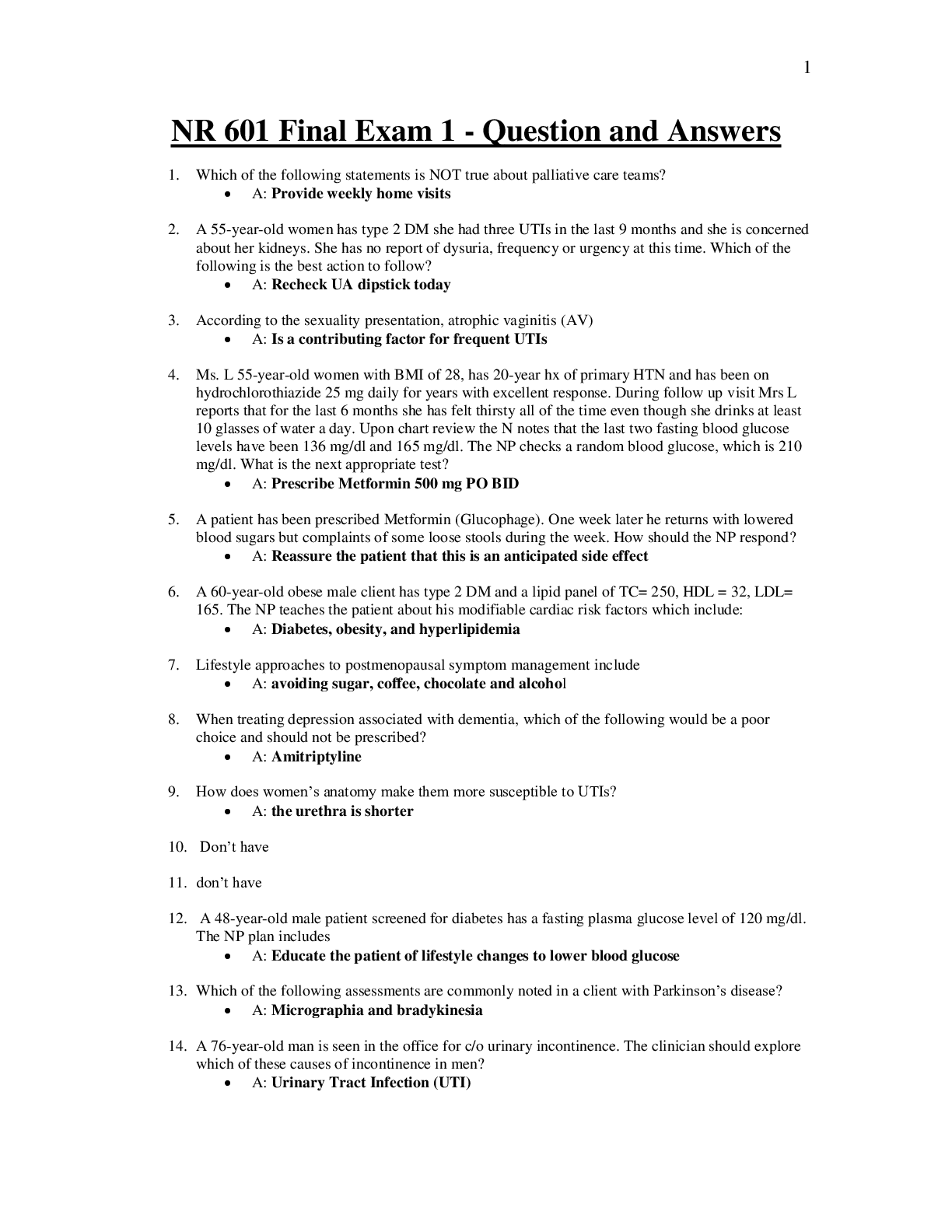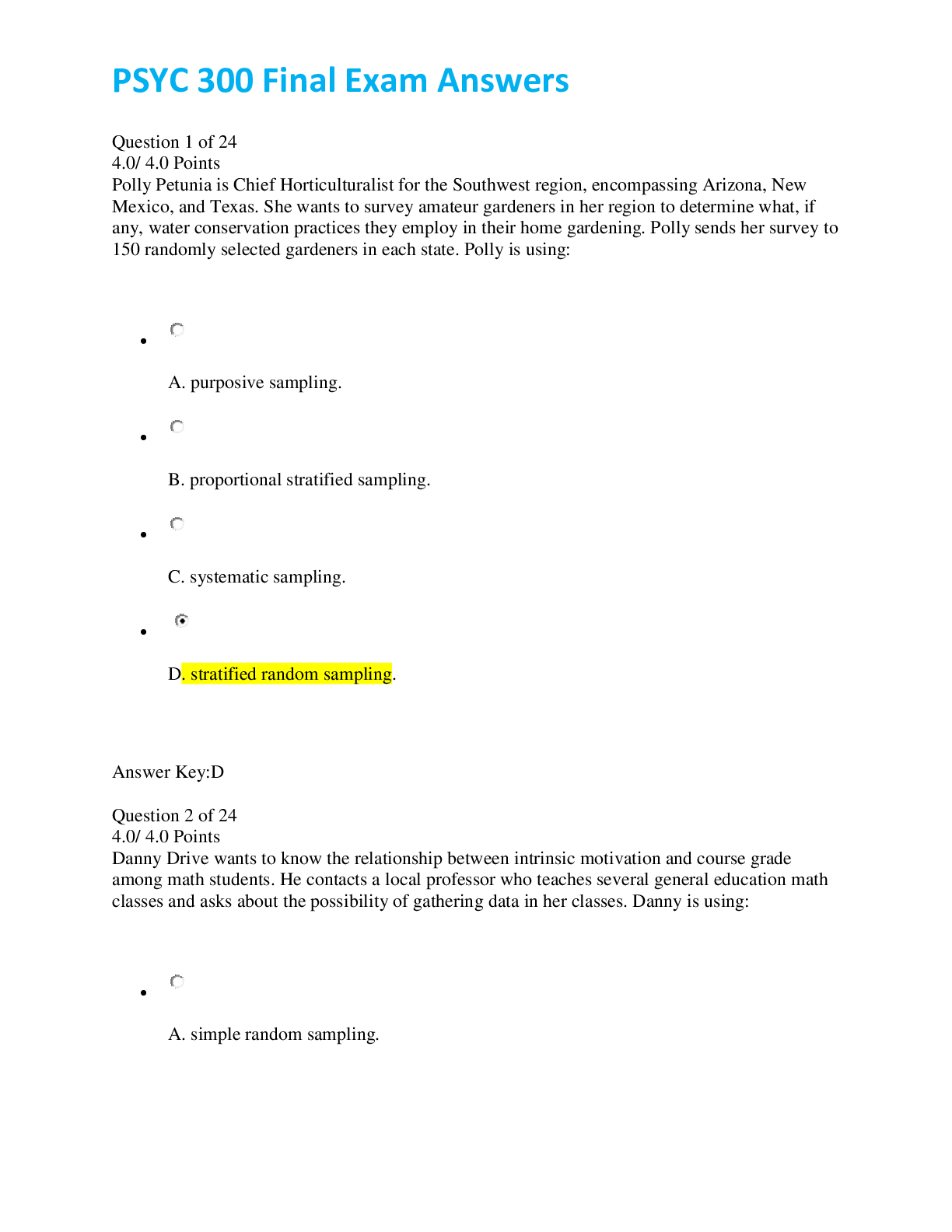MATHS 1140 FINAL EXAM 1 | GRADED A
Document Content and Description Below
MATHS 1140 FINAL EXAM 1 1. Select the member of the healthcare team that is paired with one of the main functions of this team member. Occupational therapist: Gait exercises Physical therapist: The... provision of assistive devices to facilitate the activities of daily living Speech and language therapist: The treatment of swallowing disorders Case manager: Ordering medications and treatments 2. The recommended daily caloric intake for sedentary older men, active adult women and children is: 2400 calories 1600 calories 2800 calories 2000 calories 3. Ill health, malnutrition, and wasting as a result of chronic disease are all associated with: Surgical asepsis Catabolism Cachexia Venous stasis 4. Select all the possible opportunistic infections that adversely affect HIV/AIDS infected patients. Visual losses Kaposi’s sarcoma Wilms’ sarcoma Tuberculosis Peripheral neuropathy Toxoplasma gondii Show Correct Response >>> 5. What can help reduce a patient’s anxiety and postsurgical pain? Preoperative teaching Preoperative checklist Psychological counseling Preoperative medication. 6. Which disease decreases the metabolic rate? Cancer Hypothyroidism Chronic obstructive pulmonary disease Cardiac failure 7. When caring for an infant during cardiac arrest, which pulse must be palpated to determine cardiac function? Carotid Brachial Pedal Radial 8. The patient should be sitting when deep breathing and coughing because this position: Is physically more comfortable for the patient Helps the patient to support their incision with a pillow Loosens respiratory secretions Allows the patient to observe their area and reed 9. Which procedures necessitate the use of surgical asepsis techniques? Select all that apply. Intramuscular medication administration Central line intravenous medication administration Donning gloves in the operating room Neonatal bathing Foley catheter insertion 10.The client is receiving tobramycin intravenously every 8 hours. Which finding would indicate to the nurse that the client is experiencing an adverse medication effect? 1."Where is the pain located, and does it radiate to other parts of your body? 2."How would you describe the pain, and how is it affecting you?" 3"What do you believe about pain medication and drug addiction? 4."How is the pain affecting your activity level and your ability to function?" 11- The nurse caring for a client who is taking an aminoglycoside should monitor the client for which adverse effects of the medication? Select all that apply. 1. Seizure 2. Toxicity 3. Renal toxicity 4. Dysrhythmias 5. Hepatotoxicity 12. Azathioprine (Imuran) is prescribed for a client to suppress rejection of a renal transplant. In planning for administration of the medication, the nurse understands that which description is the mechanism of action of this medication? 1. It cross-links DNA. 2. It blocks all T-cell functions. 3. It inhibits the proliferation of B and T lymphocytes. 4. It decreases the activity of thymus-derived lymphocytes. 13.The nurse is caring for a client who is receiving immunosuppressant therapy, including corticosteroids, after renal transplantation. The nurse should plan to carefully monitor results of which laboratory test for this client? 1. Blood glucose level 2. Serum calcium level 3. Serum magnesium level 4. Serum albumin concentration 14. A client with acquired immunodeficiency syndrome is suspected of having cutaneous Kaposi's sarcoma. The nurse should prepare the client for which test to confirm the presence of this type of sarcoma? 1. Liver biopsy 2. Sputum culture 3. White blood cell count 4. Punch biopsy of the cutaneous lesions 15. Azathioprine (Imuran) is prescribed for a client to suppress rejection of a renal transplant. In planning for administration of the medication, the nurse understands that which description is the mechanism of action of this medication? 1. It cross-links DNA. 2. It blocks all T-cell functions. 3. It inhibits the proliferation of B and T lymphocytes. 4. It decreases the activity of thymus-derived lymphocytes. 16. A client with acquired immunodeficiency syndrome is suspected of having cutaneous Kaposi's sarcoma. The nurse should prepare the client for which test to confirm the presence of this type of sarcoma? 1. Liver biopsy 2. Sputum culture 3. White blood cell count 4. Punch biopsy of the cutaneous lesions 17. The nurse is providing instructions to a client regarding the side effects of chlorpromazine (Thorazine). The nurse instructs the client that which may occur with the use of this medication? 1. Dry mouth 2. Hand tremors 3. Lip smacking 18. Increased urinary output the nurse is monitoring a client with a diagnosis of schizophrenia. The nurse notes that the client's emotional responses to situations occurring throughout the day are incongruent with the tone of the situation. The nurse should document the findings using which description of the client's behavioral response? 1.Flat affect 2. Bizarre affect 3. Blunted affect 4. Inappropriate affect 19. A mental health nurse notes that a client with schizophrenia is exhibiting an immobile facial expression and a blank look. Which should the nurse document in the client's record? 1. The client has a flat affect. 2. The client has an inappropriate affect. 3. The client is exhibiting bizarre behavior. 4. The client's emotional responses exhibit a blunted affect. 20. The nurse is developing a plan of care for the client with a diagnosis of paranoia and should include which interventions in the plan of care? Select all that apply. 1. Provide a warm approach to the client. 2. Ask permission before touching the client. 3. Eliminate physical contact with the client. 4. Defuse any anger or verbal attacks with a nondefense stance. 5. Use simple and clear language when communicating with the client. 21. A client with acquired immunodeficiency syndrome (AIDS) has been started on therapy with zidovudine (Retrovir). The nurse should monitor the results of which laboratory blood study for adverse effects of therapy? 1.Creatinine level 2.Potassium concentration 3.Complete blood count (CBC) 4.Blood urea nitrogen (BUN) level 22. Ketoconazole is prescribed for a client with a diagnosis of candidiasis. Which interventions should the nurse include when administering this medication? Select all that apply. 1. Restrict fluid intake. 2. Monitor liver function studies. 3. Instruct the client to avoid alcohol. 4. Administer the medication with an antacid. 5. Instruct the client to avoid exposure to the sun. 6. Administer the medication on an empty stomach. 23. The nurse is caring for a client who has been taking a sulfonamide and should monitor for signs and symptoms of which adverse effects of the medication? Select all that apply. 1.Ototoxicity 2. Palpitations 3. Nephrotoxicity 4. Bone marrow suppression 5. Gastrointestinal (GI) effects 6. Increased white blood cell (WBC) count 24. The nurse is reviewing the results of serum laboratory studies drawn on a client with acquired immunodeficiency syndrome who is receiving didanosine. The nurse interprets that the client may have the medication discontinued by the health care provider if which elevated result is note 1.Serum protein level 2.Blood glucose level 3. Serum amylase level 4.Serum creatinine level 25. The nurse is caring for a postrenal transplantation client taking cyclosporine. The nurse notes an increase in one of the client's vital signs and the client is complaining of a headache. What vital sign is most likely increased? 1. Pulse 2. Respirations 3. Blood pressure 4. Pulse oximetry 26. Amikacin is prescribed for a client with a bacterial infection. The nurse instructs the client to contact the health care provider (HCP) immediately if which occurs? 1. Nausea 2. Lethargy 3. Hearing loss 27. Muscle aches the nurse is assigned to care for a client with cytomegalovirus retinitis and acquired immunodeficiency syndrome who is receiving foscarnet, an antiviral medication. The nurse should monitor the results of which laboratory study while the client is taking this medication? 1. CD4+ T cell count 2. Lymphocyte count 3. Serum albumin level 4. Serum creatinine level 28. A client who is human immunodeficiency virus seropositive has been taking stavudine. The nurse should monitor which most closely while the client is taking this medication? 1. Gait 2. Appetite 3. Level of consciousness 4. Gastrointestinal function 29. Tacrolimus is prescribed to a client for prevention of organ rejection after renal transplantation. Which prescription should the nurse anticipate to be prescribed, along with the tacrolimus, for this client? 1. Phenytoin 2. Prednisone 3. Fluconazole 4. Erythromycin 30. The client with acquired immunodeficiency syndrome and Pneumocystis jiroveci infection has been receiving pentamidine. The client develops a temperature of 101°F (38.3°C). The nurse continues to assess the client, knowing that this sign most likely indicates which condition? 1. That the dose of the medication is too low 2. That the client is experiencing toxic effects of the medication 3. That the client has developed inadequacy of thermoregulation 4. That the client has developed another infection caused by leukopenia effects of the medic 31. The nurse caring for a client who is taking an aminoglycoside should monitor the client for which adverse effects of the medication? Select all that apply. 1. Seizures 2. Ototoxicity 3. Renal toxicity 4. Dysrhythmias 32. The client with acquired immunodeficiency syndrome (AIDS) has been prescribed raltegravir. The nurse determines that the client may be experiencing an adverse effect related to this medication if which assessment finding is noted? 1. Insomnia 2. Dizziness 3. Indigestion and belching 4.Temperature of 101.2°F (38.4°C 33. A client who is receiving nitrofurantoin calls the clinic complaining of troublesome effects related to the medication. Which side or adverse effect(s) indicates the need to stop treatment with this medication? 1. Nausea 2. Anorexia 3. Diarrhea 4. Cough and chest pain 34. Itraconazole is prescribed for a client with a fungal infection of the hands. The nurse provides instructions to the client about the medication. Which statement by the client indicates an understanding of the instructions? 1. "I should take the medication on an empty stomach." 2. "I should decrease my fluid intake while taking the medication." 3. "I may become unusually fatigued while taking this medication." 4. "If my urine becomes very dark in color, I should contact my health care provider (HCP). 35. An aminoglycoside, given by intermittent intravenous infusion, is prescribed for a client with an infection. Which finding would indicate to the nurse that the client is experiencing an adverse effect of the medication? 1. Bradycardia 2. Difficulty hearing 3. Increased appetite 4. Weakness and drowsiness 36.The nurse is providing discharge instructions to the mother of a child who has been prescribed tetracycline hydrochloride. The nurse stresses to the mother the importance of which measure in giving this medication to the child? 1. Give the medication with milk. 2. Use a straw when giving the medication. 3. Give the medication with chocolate milk. 4. Dilute the medication with water in a Styrofoam cup. 37. A client with acquired immunodeficiency syndrome who is taking zidovudine 200 mg orally 3 times daily has severe neutropenia noted on follow-up laboratory studies. The nurse interprets that which change is likely to occur at this point? 1. The medication dose probably will be reduced. 2. Prednisone probably will be added to the medication regimen. 3. Epoetin alfa probably will be added to the medication regimen. 4. The medication probably will be discontinued until laboratory results indicate bone marrow recovery. 38. A client with acquired immunodeficiency syndrome (AIDS) experiences nausea, vomiting, and abdominal pain radiating to the back after taking didanosine. The ambulatory care nurse should provide which response as telephone advice to this client? 1. "Take crackers and milk with each dose of the medication." 2. "Decrease the dose of the medication until the next clinic visit." 3."This is an uncomfortable but expected side or adverse effect of the medication." 4."Report to the health care clinic to be seen by the health care provider." 39. The nurse is monitoring a client who is receiving intravenous (IV) acyclovir. The nurse would monitor the client closely for which primary toxic effect of the medication? 1. Ototoxicity 2. Neurotoxicity 3. Cardiotoxicity 4. Nephrotoxicity 39. A client with human immunodeficiency virus infection is taking indinavir. The nurse plans to provide the client with which direction when providing instructions about the use of this medication? 1. Store the medication in the refrigerator. 2. Take the medication with a high-fat snack. 3. Take the medication with the large meal of the day. 4. Take the medication with water on an empty stomach. 40. A client is receiving acyclovir by the intravenous (IV) route for treatment of cytomegalovirus (CMV) infection. After reconstituting the powder dispensed by the pharmacy, the nurse should administer this medication via which method? 1. Slow IV infusion over 1 hour 2. Rapid IV bolus over 5 minutes 3. Continuous IV infusion over 24 hours 4Continuous IV infusion over 12 hours 41. The nurse is monitoring a client with herpes simplex virus (HSV) who is receiving intravenous (IV) acyclovir. Which laboratory result would be of concern as a possible adverse effect of this medication? 1. Platelet count of 300,000 mm3 (300 × 109/L) 2. Prothrombin time of 12 seconds (12 seconds) 3. White blood cell count of 6000 mm3 (6 × 109/L) 4. Blood urea nitrogen (BUN) of 36 mg/dL (12.9 ) 42. A pediatric nurse has obtained ribavirin in powder form from the pharmacy to administer to a child with respiratory syncytial virus (RSV) infection. After preparing the medication, the nurse should administer it by which route? 1. Inhalation 2. Intravenous 3. Subcutaneous 4. Oral, in the child's formula 43. A client is receiving amoxicillin orally every 8 hours. Which finding would indicate to the nurse that the client is experiencing a frequent minor side effect related to the medication? 1. Fever 2. Vaginal drainage 3. Severe watery diarrhea 4. Severe abdominal cramp 44. The nurse is creating a plan of care for a client who is receiving amphotericin B intravenously. A main component of the plan of care is monitoring for adverse effects related to the administration of this medication. Which should the nurse include in a list of manifestations to watch for? 1.Fatigue 2. Confusion 3. Visual difficulties 4. Increased urinary output 45. A client is receiving amphotericin B by the intravenous (IV) route. During ongoing therapy with this medication, the nurse should most closely assess the client for which finding that indicates a complication? 1. Decreased pulse 2. Decreased urine output 3. Decreased body temperature 46. Decreased blood urea nitrogen level the nurse is providing discharge instructions to a client who will be taking tacrolimus daily following allogenic liver transplantation. The nurse instructs the client that which is a frequent side effect related to this medication? 1. Diarrhea 2. Confusion 3. Loss of memory 4. A decrease in urine output 47. Tobramycin sulfate is prescribed. The nurse is administering the medication by intermittent intravenous infusion every 8 hours. The nurse monitors the client for signs of an adverse effect related to this medication and determines that which, if noted on assessment, would indicate its presence? 1. Client complaint of diarrhea 2. Client complaint of ringing in the ears 3. A white blood cell count of 6000 mm3 (6 × 109/L) 4. A blood urea nitrogen (BUN) of 10 mg/dL (3.6 mmol) 48. A client is receiving ganciclovir. Which nursing action is appropriate during the time the client is receiving this medication? 1. Monitoring blood glucose levels for elevation 2. Administering the medication on an empty stomach only 3. Applying pressure to venipuncture sites for at least 1 minute 4. Providing the client with a soft toothbrush and an electric razor 49. A client has been receiving foscarnet as part of therapy for the treatment of cytomegalovirus (CMV) retinitis and acquired immunodeficiency syndrome (AIDS). The home care nurse should periodically review results of which laboratory blood test to assess for adverse effects to this medication? 1. CD4+ cell count 2. Lymphocyte count 3. Albumin concentration 4. Creatinine concentration 50. A health care provider has just prescribed foscarnet to be given intravenously. The nurse should obtain which piece of equipment to administer this medication? 1. A glass bottle 2. An infusion pump 3. A micro drip tubing set 4. Special manufacturer's tubing 51. Quinupristin-dalfopristin is prescribed as an intermittent intravenous (IV) infusion. The nurse should adjust the drip rate so that the dose is administered over what period of time? 1. 1 hour 2. 4 hours 3. 15 minutes 4. 30 minutes 52. A client is scheduled to receive a first dose of pentamidine intravenously. What should the nurse plan to carefully monitor as the priority during administration of the first dose? 1. Pulse rate 2. Breath sounds 3. Blood pressure 4.Respiratory rate 53. A client has been given a prescription for a course of azithromycin. The nurse should tell the client that this medication will relieve which problem? 1. pain 2. Joint inflammation 3. High blood pressure 4.Signs and symptoms of infection 54. The nurse is caring for a client with a urinary tract infection (UTI). The culture report reveals the presence of Pseudomonas aeruginosa. The nurse anticipates that which medication will be prescribed to treat the infection? 1. Isoniazid 2.Rifampin 3.Ethambutol 4.Ciprofloxacin 55. The home health nurse is visiting a client who has been started on therapy with clotrimazole. The nurse should monitor which item to monitor the effectiveness of this medication with each visit? 1. Rash 2. Fever 3. Pain relief 4.Sore throat 54. Levofloxacin is prescribed for a client. While teaching the client about the medication, what should the nurse tell the client to take the medication with? 1. Water 2. An antacid 3. A zinc preparation 4. An iron supplement 55. A child with human immunodeficiency virus (HIV) infection is receiving zidovudine. Which finding indicates to the nurse that the child may be experiencing an adverse effect from the medication? 1. The child complains of pain in his lower legs. 2. The child's skin is pale and his child is feeling tired. 3. The child has some swelling in the hands and around the ankles. 4. The child is clinging to his parents and won't allow them to leave. 56. The clinic nurse is providing medication instructions to a client who will be receiving hydroxychloroquine sulfate. The nurse instructs the client about the importance of returning to the clinic in 6 months for which follow-up test? 1. Sigmoidoscopy 2. Eye examination 3. Chest radiograph 4. Dental examination 57. Pyrimethamine has been added to the medication regimen for a client with acquired immunodeficiency syndrome. On review of the client's record, the nurse notes this new prescription and plans care knowing that it has been prescribed to treat which condition? 1.Toxoplasmosis with human immunodeficiency virus (HIV) infection is receiving 1. Sigmoidoscopy 2. Eye examination 3. Chest radiograph 4. Dental examination 58. Pyrimethamine has been added to the medication regimen for a client with acquired immunodeficiency syndrome. On review of the client's record, the nurse notes this new prescription and plans care knowing that it has been prescribed to treat which condition? 1.Toxoplasmosis 2. Kaposi's sarcoma 3. Cardiac irregularities 4. Nausea and vomiting 59. Dapsone is prescribed to treat toxoplasmosis in a client with acquired immunodeficiency syndrome. The nurse reinforces medication instructions and tells the client to perform which action? 1. Report to the clinic weekly for the injections. 2. Plan to take the medication every 6 hours around the clock. 3.Discontinue the medication if nausea and vomiting develop. 4. Contact the health care provider (HCP) if fever or a sore throat occurs. 60. Cyclosporine is prescribed for a client who received a kidney transplant. The nurse would be most concerned if a review of the medical record revealed that the client currently is taking which prescribed medication? 1.Digoxin 2.Phenytoin 3.Prednisone 4.Propranolol 61. Cyclosporine is prescribed to be administered by the intravenous (IV) route. Which is an inappropriate action in preparing and administering this medication? 1.Mixing the solution and covering it with a paper bag 2.Administering the medication over a period of 2 to 6 hours 3.Mixing 1 mL of concentrate in 50 mL of 0.9% sodium chloride and administering by infusion 4.Mixing 1 mL of concentrate in 10 mL of 0.9% sodium chloride and administering by bolus injection 62 Muromonab-CD3 is prescribed for a client to manage allograft rejection after renal transplantation. The nurse plans care, knowing that the primary mechanism of action of this medication is what? 1. Suppresses B lymphocytes 2. Inhibits the proliferation of B lymphocytes 3. Crosslinks DNA, causing cell injury and death 4. Binds to the CD3 site and blocks all T-cell functions 63.The nurse is preparing to administer a prescribed dose of cyclosporine by intravenous (IV) administration. Which priority item would the nurse have available during administration of this medication? 1. A code cart 2. Oral airway 3.Epinephrine 4. A suction catheter 64. A client taking an antihistamine is scheduled for allergy skin testing and tells the nurse in the health care provider's office that a dose was taken this morning. The nurse interprets this to mean that which adjustment needs to be made? 1. A lower dose of allergen should be injected. 2. A higher dose of allergen should be injected. 3. The client should reschedule the appointment. 65. The client should have the ski Abacavir has been prescribed for a client, and the client asks the nurse about the action of the medication. How should the nurse respond? 1.Promotes viral DNA growth 2.Prevents the production of DNA 3.Splits DNA to prevent its production 4.Inhibits activity of HIV-1 reverse transcriptase 66. Abacavir has been prescribed for a client. The nurse tells the client that which blood test will be done periodically while the client is taking this medication? 1.Platelet count 2.Liver function tests 3.Serum creatinine assay 4.Blood urea nitrogen determination 67. Abacavir has been prescribed for a client, who asks the nurse about the side effects of the medication. What should the nurse tell the client is a frequent side effect of this medication? 1.Nausea 2.Sleepiness 3.Constipation 4.Increased appetite 68.A client admitted to the hospital is taking abacavir. The nurse should monitor the client for which adverse effect of the medication? 1.Insomnia 2.Diarrhea 3.Hypotension 4.Decreased appetite 69. Abacavir has been prescribed for a client, and the nurse provides instructions about the medication. Which statement by the client indicates the need for further instruction? 1."This medication will not cure my infection." 2. "Eating small, frequent meals will help offset the nausea." 3."This medication will reduce the risk of transmitting the infection to others." 4."I should check with my health care provider before taking any over-the-counter medications." 70. The nurse is collecting subjective and objective data from a client and notes that the client is taking zidovudine. The nurse determines that this medication has been prescribed to treat which condition? 1.Ulcerative colitis 2.Hyperthyroidism 3.Addison's diseases 4.Human immunodeficiency virus (HIV) infection 70. Zidovudine has been prescribed for a client who asks the nurse about the action of the medication. The nurse responds that this medication performs which function? 1. Increases neutrophils 2. Kills bacteria and fungi 3.Promotes the function of natural killer cells 4.Slows the replication of human immunodeficiency virus (HIV) 71.A client seen in the health care clinic is diagnosed with syphilis, and the health care provider prescribes an intramuscular injection of penicillin G benzathine. After administering the intramuscular injection of medication, the nurse should perform which action? 1.Monitor the client for 30 minutes. 2.Encourage the client to ambulate. 3.Administer subcutaneous epinephrine. 72. Apply a topical anesthetic spray to the injection site. The health care provider (HCP) writes a prescription for zidovudine for a client who was admitted to the hospital. The nurse should contact the HCP to verify the prescription if which finding is noted in the assessment data? 1.History of renal calculi 2.Complaints of diarrhea 3.Bone marrow depression 4.Complaints of abdominal discomfort 73. Zidovudine has been prescribed for a client. The nurse should tell the client that which blood test will be done periodically while the client is taking this medication? 1.Urea nitrogen level 2.Magnesium and calcium levels 3.Complete blood cell (CBC) count 4.Sedimentation rate and prothrombin time 74.Zidovudine has been prescribed for a client, and the client asks the nurse about the side effects of the medication. The nurse responds that which is a common side effect of this medication? 1.Lethargy 2.Weakness 3.Headache 4.Constipation 75.A client admitted to the hospital is taking zidovudine. The nurse monitors the client for which adverse effect of the medication? 1.Colitis 2.Ototoxicity 3.Neurotoxicity 4.Visual disturbances [Show More]
Last updated: 1 year ago
Preview 1 out of 18 pages
Instant download

Buy this document to get the full access instantly
Instant Download Access after purchase
Add to cartInstant download
Reviews( 0 )
Document information
Connected school, study & course
About the document
Uploaded On
Feb 06, 2021
Number of pages
18
Written in
Additional information
This document has been written for:
Uploaded
Feb 06, 2021
Downloads
0
Views
31













